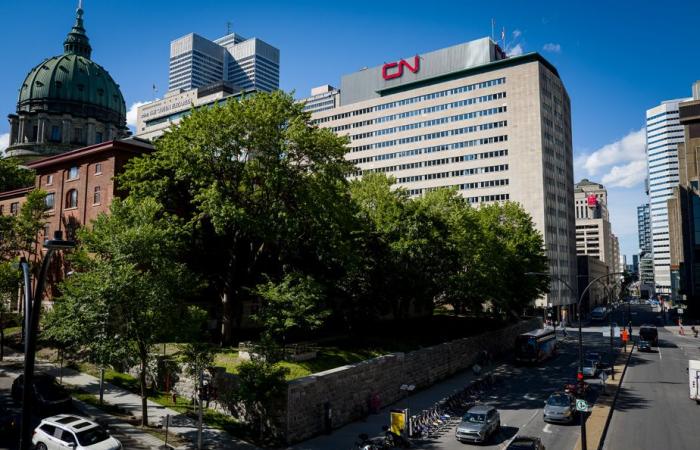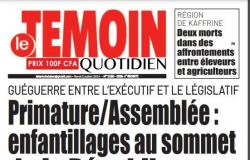There is no shortage of depressing numbers these days when it comes to housing.
Posted at 1:32 a.m.
Updated at 5:00 a.m.
There are the vacancy rates, tiny. The construction starts, starving. The rents, skyrocketing. The families evicted, ever more numerous. I could throw entire paragraphs at you…
I will focus on just one number today. An apparently abstract figure, but also full of promises: 1 million.
More precisely: 1 million square feet.
This is the quantity of office space that could be converted into housing in downtown Montreal. Transformation projects are underway or under study in at least four buildings, I learned, and half a dozen others, or more, could follow.
The potential is huge, if the right conditions are met. It has been seen elsewhere and there is no reason why it should not work here.
I went to Calgary last year to look at the phenomenon of conversions, a city that has become, in spite of itself, the North American epicentre for such projects.1.
The oil price crash of 2014 and the COVID-19 pandemic sent office vacancy rates soaring to more than 30%. The exodus of tenants caused their property values to plummet by $16 billion. This decline, in turn, ate into the city’s tax revenues.
A vicious spiral that the Alberta metropolis has managed to transform into an opportunity.
How ? With a generous subsidy program aimed at private developers. And bureaucracy reduced to its strictest minimum, to speed up construction sites.
It worked like a charm. Over the past three years, 13 conversion projects have been launched and four more are under consideration. These transformations will add 2,300 housing units to the heart of the city. A win-win situation.
Downtown Montreal is in a better position than Calgary. It is more populated. More diverse.
But a very real danger looms. The vacancy rate for office buildings has doubled since the pandemic, to 18.5%. Working in hybrid mode is not about to disappear, which leaves a significant number of towers to be requalified.
I was interested in a project that is discreetly progressing on rue Sherbrooke Ouest, near McGill University. A Halifax company, NexArm Investments, bought the former Standard Life building a year ago for $50 million with a view to transforming it.
The 21-story tower will be converted into 209 rental apartments. The project is progressing smoothly, George Armoyan Jr., who manages the Quebec real estate projects of this family business, confirmed to me in an interview.
In fact, the borough of Ville-Marie and the City of Montreal have shown surprising speed in this matter.
The transaction was concluded in June 2023 and the conversion permit, which allowed the interior of the building to be demolished, was issued in September.
The final permit for the conversion, which will involve, among other things, replacing all the windows, was issued recently, so in less than a year.
It must be emphasized that the project benefits from a major advantage: the zoning is mixed in this sector of the city center. It allows residential and commercial use. A change request would have added considerable delay.
But the fact of converting an existing building, rather than demolishing it and rebuilding anew, adds enormous “speed of execution” to the project, George Armoyan Jr. told me. “We inherit starting from the structure and from the facade, everything is there. »
He expects the apartments to be delivered in less than a year. The total bill – as well as the amount of rent – remains unknown.
According to real estate firm Avison Young, at least three other conversion projects are at various stages of progress downtown: René-Lévesque Boulevard West, Sainte-Catherine Street West and in the former CN headquarters on De La Gauchetière Street West.
-
PHOTO DOMINICK GRAVEL, LA PRESSE
A conversion is planned in this tower on René-Lévesque Boulevard West.
-

PHOTO DOMINICK GRAVEL, LA PRESSE
A conversion and densification project is envisaged on this site.
-
PHOTO DOMINICK GRAVEL, LA PRESSE
One of the few recent office conversions, recently completed on Nuns’ Island
1/3
If they come to fruition, they will total more than a million square feet. These transformations would reduce the office vacancy rate in the city center by 1% to 1.5%, in addition to creating hundreds of housing units.
The conversion potential is great in Montreal, but so is the complexity of the projects, two experts from Avison Young reminded me.
Buildings, for example, must have a fairly limited floor area so that all apartments have access to windows. There are often zoning changes to be made, or floors to be added, which can add major delays. They hope that the City will show more “flexibility” by allowing densification when necessary.
The Plante administration says it is “hyper favorable” to this type of project. But for the moment there is no question of following in Calgary’s footsteps with a subsidy program.
Expect growing debates in this regard. The pressure will increase for the City to be less passive in this matter. The Urban Development Institute of Quebec, which represents developers, notably requested property tax credits or subsidies a few weeks ago.
Justified requests, in my opinion.
We agree: these conversions will not solve the housing crisis. The apartments that will be delivered, like those on Sherbrooke Street West, will be far from being affordable for everyone.
But we have said it again and again: we must increase supply in all price ranges. The Canada Mortgage and Housing Corporation confirmed this again in a recent study. Building more units, even more expensive ones, creates a ripple effect that frees up more affordable apartments2.
There is a large pool of buildings to convert, in Montreal and elsewhere in Quebec. Let us facilitate these transformations at all costs. In addition to being ecological, it is simply logical.
1. Read “How to Save a Downtown”
2. Consult the Canada Mortgage and Housing Corporation research








